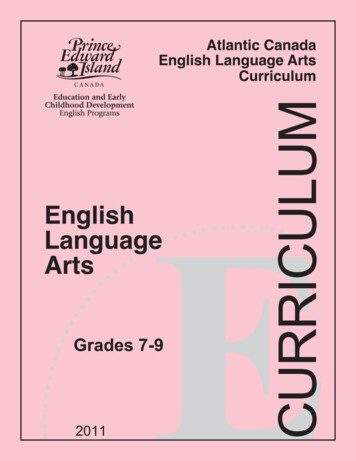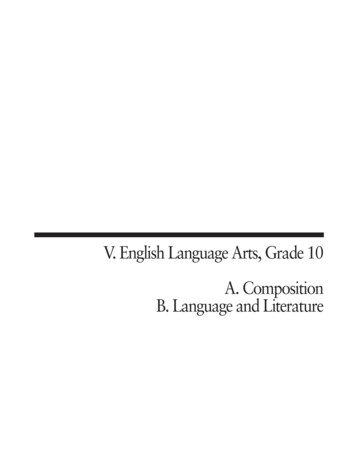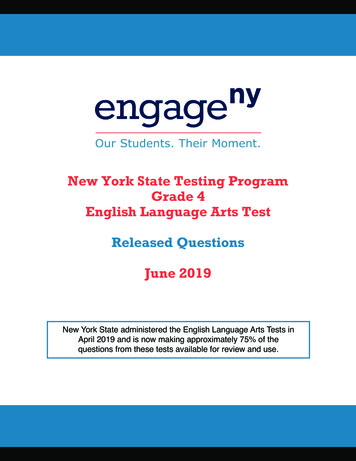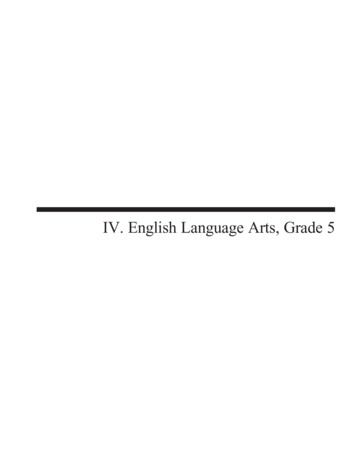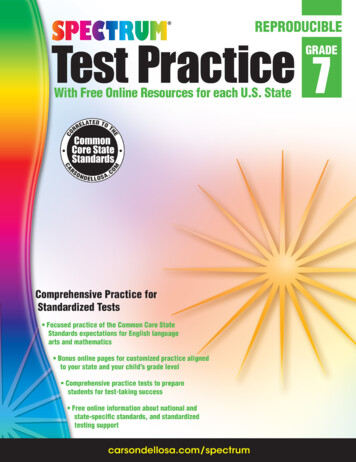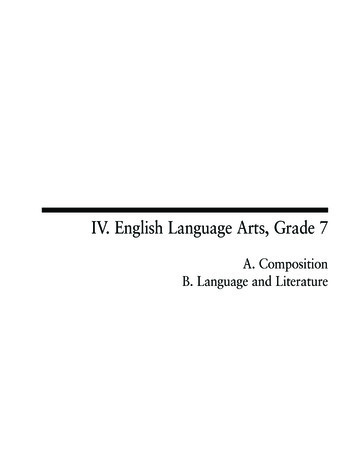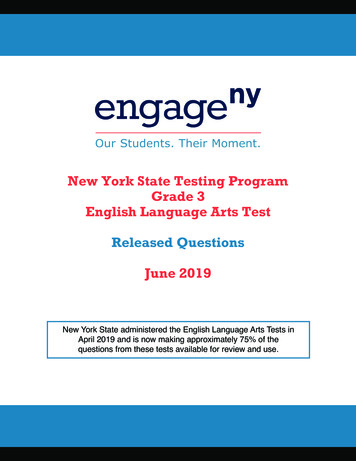
Transcription
New York State Testing ProgramGrade 3English Language Arts TestReleased QuestionsJune 2019New York State administered the English Language Arts Tests inApril 2019 and is now making approximately 75% of thequestions from these tests available for review and use.
THE STATE EDUCATION DEPARTMENT / THE UNIVERSITY OF THE STATE OF NEW YORK / ALBANY, NY 12234New York State Testing ProgramGrades 3–8 English Language ArtsReleased Questions from 2019 ExamsBackgroundIn 2013, New York State began administering tests designed to assess student performance in accordancewith the instructional shifts and rigor demanded by the new New York State P-12 Learning Standards inEnglish Language Arts (ELA). To help in this transition to new assessments, the New York State EducationDepartment (SED) has been releasing an increasing number of test questions from the tests that wereadministered to students across the State in the spring. This year, SED is again releasing large portions ofthe 2019 NYS Grades 3–8 English Language Arts and Mathematics test materials for review, discussion, anduse.For 2019, included in these released materials are at least 75 percent of the test questions that appearedon the 2019 tests (including all constructed-response questions) that counted toward students’ scores.Additionally, SED is providing information about the released passages; the associated text complexity foreach passage; and a map that details what learning standards each released question measures and thecorrect response to each question. These released materials will help students, families, educators, and thepublic better understand the tests and the New York State Education Department’s expectations forstudents.Understanding ELA QuestionsMultiple-Choice QuestionsMultiple-choice questions are designed to assess the New York State P-12 Learning Standards in EnglishLanguage Arts. These questions ask students to analyze different aspects of a given text, including centralidea, style elements, character and plot development, and vocabulary. Almost all questions, includingvocabulary questions, will be answered correctly only if the student comprehends and makes use of thewhole passage.For multiple-choice questions, students select the correct response from four answer choices. Multiplechoice questions assess reading standards in a variety of ways. Some ask students to analyze aspects of textor vocabulary. Many questions require students to combine skills. For example, questions may ask studentsto identify a segment of text that best supports the central idea. To answer these questions correctly, astudent must first comprehend the central idea and then show understanding of how that idea is supported.Questions tend to require more than rote recall or identification.Short-Response QuestionsShort-response questions are designed to assess New York State P-12 Reading and Language Standards.These are single questions in which a student uses textual evidence to support his or her answer to aninferential question. These questions ask the student to make an inference (a claim, position, or conclusion)
based on his or her analysis of the passage, and then provide two pieces of text-based evidence to supporthis or her answer.The purpose of the short-response questions is to assess a student’s ability to comprehend and analyzetext. In responding to these questions, students are expected to write in complete sentences. Responsesrequire no more than three complete sentences. The rubric used for evaluating short-response questionscan be found in the grade-level Educator Guides at sh-language-arts-and-mathematics.Extended-Response QuestionsExtended-response questions are designed to measure a student’s ability to write from sources. Questionsthat measure Writing from Sources prompt students to communicate a clear and coherent analysis of oneor two texts. The comprehension and analysis required by each extended response is directly related tograde-specific reading standards. Student responses are evaluated on the degree to which they meet gradelevel writing and language expectations. This evaluation is made by using a rubric that incorporates thedemands of grade-specific New York State P-12 Reading and Language standards.The integrated nature of the standards for ELA and literacy requires that students are evaluated across thestrands (Reading, Writing, and Language) with longer pieces of writing, such as those prompted by theextended-response questions. The rubric used for evaluating extended-response questions can be found inthe grade-level Educator Guides at ish-languagearts-and-mathematics.New York State P-12 Learning Standards AlignmentThe alignment(s) to the New York State P-12 Learning Standards for English Language Arts is/are intendedto identify the analytic skills necessary to successfully answer each question. However, some questionsmeasure proficiencies described in multiple standards, including writing and additional reading andlanguage standards. For example, two-point and four-point constructed-response questions requirestudents to first conduct the analyses described in the mapped standard and then produce writtenresponses that are rated based on writing standards. To gain greater insight into the measurement focusfor constructed-response questions, please refer to the rubrics.These Released Questions Do Not Comprise a “Mini Test”To ensure future valid and reliable tests, some content must remain secure for possible use on futureexams. As such, this document is not intended to be representative of the entire test, to show howoperational tests look, or to provide information about how teachers should administer the test; rather, itspurpose is to provide an overview of how the test reflects the demands of the New York State P-12 LearningStandards.The released questions do not represent the full spectrum of the standards assessed on the State tests, nordo they represent the full spectrum of how the standards should be taught and assessed in the classroom.It should not be assumed that a particular standard will be measured by an identical question in futureassessments. Specific criteria for writing test questions, as well as additional assessment information, areavailable at http://www.engageny.org/common-core-assessments.
2019 Grade 3 ELA Test Text Complexity Metrics forReleased Questions Available on EngageNYSelecting high‐quality, grade‐appropriate passages requires both objective textcomplexity metrics and expert judgment. For the Grades 3–8 assessments based on theNew York State P‐12 Learning Standards for English Language Arts, both quantitative andqualitative rubrics are used to determine the complexity of the texts and their appropriateplacement within a grade‐level ELA exam.Quantitative measures of text complexity are used to measure aspects of text complexitythat are difficult for a human reader to evaluate when examining a text. These aspectsinclude word frequency, word length, sentence length, and text cohesion. These aspectsare efficiently measured by computer programs. While quantitative text complexitymetrics are a helpful start, they are not definitive.Qualitative measures are a crucial complement to quantitative measures. Usingqualitative measures of text complexity involves making an informed decision about thedifficulty of a text in terms of one or more factors discernible to a human reader applyingtrained judgment to the task. To qualitatively determine the complexity of a text,educators use a rubric composed of five factors; four of these factors are required andone factor is optional. The required criteria are: meaning, text structure, languagefeatures, and knowledge demands. The optional factor, graphics, is used only if a graphicappears in the text.To make the final determination as to whether a text is at grade‐level and thusappropriate to be included on a Grades 3–8 assessment, New York State uses a two‐stepreview process, which is an industry best‐practice. First, all prospective passages undergoquantitative text complexity analysis using three text complexity measures. If at least twoof the three measures suggest that the passage is grade‐appropriate, the passage thenmoves to the second step, which is the qualitative review using the text‐complexityrubrics. Only passages that are determined appropriate by at least two of threequantitative measures of complexity and are determined appropriate by the qualitativemeasure of complexity are deemed appropriate for use on the exam.For more information about text selection, complexity, and the review process pleaserefer xt‐complexity‐grades‐9‐12
Degrees ofReading Power*Flesch‐KincaidFlying on IceExcerpt from Nature's Fireworks: A BookAbout LightningMeet the TeacherExcerpt from Just the Right GiftDon't Touch Me!WordCount643458LexilePassage TitleReading MaturityMetric*Text Complexity Metrics for 2019 Grade 3 ppropriateAppropriateAppropriate* Depending on when the passage was selected, either the Reading Maturity Metric or Degrees of Reading Power wasused as the third quantitative metric.New York State 2019 Quantitative Text Complexity Chart for Assessment and CurriculumTo determine if a text’s quantitative complexity is at the appropriate grade level, NewYork State uses the table below. In cases where a text is excerpted from a large work, onlythe complexity of the excerpt that students see on the test is measured, not the largework, so it is possible that the complexity of a book might be above or below grade level,but the text used on the assessment is at grade level. Because the measurement of textcomplexity is inexact, quantitative measures of complexity are defined by grade bandrather than by individual grade level and then paired with the qualitative review by –10th11th–12thATOS2.75 – 5.144.97 – 7.037.00 – 9.989.67 – 12.0111.20 – 14.10Degrees ofReadingPower42 – 5452 – 6057 – 6762 – 7267 – 74Source: Student Achievement PartnersFlesch-Kincaid1.98 – 5.344.51 – 7.736.51 – 10.348.32 – 12.1210.34 – 14.20The LexileFramework420 – 820740 – 1010925 – 11851050 – 13351185 – 1385ReadingMaturity3.53 – 6.135.42 – 7.927.04 – 9.578.41 – 10.819.57 – 12.00SourceRater0.05 – 2.480.84 – 5.754.11 – 10.669.02 – 13.9312.30 – 14.50
RELEASED QUESTIONS
“Flying on Ice” by Valerie Hunter, Spider, January 2016. Used with permission of Carus Publishing Company via Copyright ClearanceCenter.Excerpt from Nature’s Fireworks: A Book About Lightning by Josepha Sherman. Copyright 2004 by Josepha Sherman. Used withpermission via Copyright Clearance Center.Developed and published under contract with the New York State Education Department by Questar Assessment Inc., 5550 Upper 147thStreet West, Minneapolis, MN 55124. Copyright 2019 by the New York State Education Department.Session 1
Session 1TIPS FOR TAKING THE TESTHere are some suggestions to help you do your best: Be sure to read all the directions carefully. ost questions will make sense only when you read the whole passage. You may readMthe passage more than once to answer a question. When a question includes a quotationfrom a passage, be sure to keep in mind what you learned from reading the wholepassage. You may need to review both the quotation and the passage in order to answerthe question correctly. Read each question carefully and think about the answer before making your choice.Session 1Page 1
Read this story. Then answer questions 1 through 6.Flying on Iceby Valerie Hunter1Craig watched his older sister, Riley, and her friend Liz race up anddown the lake on their skates, dodging the other hockey players. eirskate blades looked like silver smoke.2When the game was over, the girls skated up to the bench where Craigwas sitting. Craig asked Riley what skating felt like.3“When I go really fast, I feel like I’m flying,” she said.4 at’s silly, thought Craig. Flying is something birds do in the air, notsomething people do on ice skates. en he watched Riley go back out onthe ice. She skated around and around the edge of the lake with her armspumping and her scarf trailing behind her. Soon she was going so fast thather arms looked like wings and her scarf looked like a feathery tail. Maybeskating really was like flying.5When Riley sat down to take her skates off, Craig said, “I wish I couldfly.”6Riley retied her skate laces and crouched next to Craig. “Get on myback,” she said, and Craig did. Riley started skating, but Craig didn’t feellike he was flying. It just felt like a wobbly piggy-back ride.7“You’re too heavy,” Riley said. “I can’t go fast when I’m carryingyou.” She skated slowly back to the bench. Craig got off her back.8“Even if you could go fast, I wouldn’t be flying,” he said sadly. “I needskates to fly.”9Riley didn’t say anything on the walk home, but a few days later sheasked Craig if he wanted to go skating.1011Page 2“To watch?” he asked.“No, to skate,” she said cheerfully. “Mom and I found a pair of my oldskates. ey might fit you.”GO ONSession 1
12 e skates were a little big, but when Riley stuffed newspaper in the toes,they fit. Craig couldn’t stop smiling. He didn’t want to take them off, buthe had to so he could walk to the lake.13Riley and Liz went with him. ey carried their hockey sticks, twoorange cones, and a wooden chair. When they got to the lake, Craig put hisskates back on and Riley helped him onto the ice. en she put his handson the back of the chair.14“Hang on to this and you won’t fall,” she said. “Just push it along in frontof you, OK?”15Craig grinned. “OK.” His feet felt wobbly, but he held on to the chair andhe didn’t fall. Riley and Liz cheered him on as he started to move forward. en they set up the cones and practiced passing the puck to each otherand shooting goals.16Craig watched them. ey made skating look easy. He tried to skate likethem, but when he let go of the chair he fell. So he grabbed on to it againand inched along. His skate blades went scritch scritch scritch instead ofthe swish swish sound that his sister’s blades made. is wasn’t like flyingat all. It was like being a snail.17“Ready to go home?” Riley finally asked.18Craig nodded, frowning. Riley had never said how hard skating was.19“What’s wrong?” she asked.20“I wanted to skate like you,” Craig said. “I wanted to fly.”21“Someday you will,” Riley said. “It takes practice.” She patted hisshoulder. en she whispered something to Liz, who grinned and winkedat Craig. Each girl took one of Craig’s hands.22“Someday you’ll fly on your own,” Riley said. “But today Liz and I willhelp you.”23Riley and Liz started skating, pulling Craig with them. e edges of hisskate blades just touched the ice. e girls went faster and faster, and so didhe. When he looked down, his skate blades were a silver blur. His hatnearly blew off.24“I’m flying!” he yelled, and the words blew away in the wind like a bird’shappy song.GO ONSession 1Page 3
123What does the word “crouched” mean as it is used in paragraph 6?Aspun aroundBbent downCstood upDfell overIn paragraph 9, what is the most likely reason Riley stays quiet as she and Craig walkhome?AShe is thinking about how well she played hockey.BShe is upset with Craig because he hurt her back.CShe is thinking about how to get skates for Craig.DShe is tired from skating in the hockey game.What does paragraph 12 help the reader understand about Craig?ACraig is too young to learn how to skate.BCraig is very excited about learning to skate.CCraig is unable to take the skates off by himself.DCraig is worried that his sister will take the skates back.Page 4GO ONSession 1
456In paragraph 16, what does the phrase “like being a snail” help the reader to understandabout Craig?AHe skates very slowly.BHe moves in a crooked line.CHe searches for a place to hide.DHe looks like all the other skaters.Which sentence best describes how paragraph 6 relates to paragraph 23?AParagraph 6 provides a problem and paragraph 23 provides asolution.BParagraph 6 asks a question and paragraph 23 provides an answer.CParagraph 6 provides a cause and paragraph 23 shows an effect.DParagraph 6 provides similarities and paragraph 23 shows differences.Which sentence best describes a central message of the story?AChange is normal and an important part of life.BFriendships o en become stronger over time.CNew experiences can be exciting and wonderful.DNatural talent is more important than practice.GO ONSession 1Page 5
Read this passage. Then answer questions 7 through 12.Excerpt from Nature’s Fireworks:A Book About Lightningby Josepha Sherman12Flash! Lightning streaks from a dark cloud.Crash! under shakes our roofs and windows. A lightning stormdazzles the sky like flickering fireworks.Lightning Begins3High above the ground, water droplets and ice crystals swirl and swarminside the moving clouds. e tiny particles bump into one another. Whenthe particles rush together, they become charged. Electricity is created.Lightning is Electricity4Page 6A single stroke of lightning carries millions of volts of electricity. Eachstroke heats the air in its path to as much as 50,000 degrees Fahrenheit(27,760 degrees Celsius). at is five times as hot as the surface of the sun.GO ONSession 1
Lightning Around the World8Every day, lightning flashes from thousands of thunderstorms aroundthe world. Every second, more than 100 lightning bolts hit the ground.Lightning can strike a tree or dry grass. When this happens, a wildfire canstart. Lightning bolts can hit tall buildings. ey also can hit electricaltowers, houses, and cars.9Flash! Lightning is streaking through the clouds. Every flash is anotherdisplay of nature’s fireworks.Fast Facts10It does not have to be raining outside for lightning to strike. Lightningcan strike both before and a er the rain falls, or even when there is no rainat all. Lightning helps nature by putting nitrogen into the ground and air.Nitrogen is a nutrient. at means it feeds plants and helps them grow.Safety Tips11Windows, water faucets, pipes, telephones, and electrical outlets can bedangerous when there is lightning in the sky. You should not run water ortalk on the phone if you see lightning. You could get an electrical shock.12Benjamin Franklin once flew a kite in a lightning storm. at is how helearned about electricity. But today, we know lightning is very dangerous. Ifyou see lightning, you should go indoors right away.Page 8GO ONSession 1
789According to paragraph 5, what happens right before thunder can be heard?ALittle drops of water move around in the sky.BDark clouds appear in the sky.CRain droplets start to fall from the clouds.D e air spreads because of heat from lightning.What is the main idea of paragraph 6?ALightning can reach from the sky to the ground.BA bolt of lightning can travel up to nine miles.CFlashes of lightning can jump from one cloud to another.DLightning can move over large distances very quickly.Which idea from the passage does the second illustration best support?ALightning can be helpful for nature.BLightning moves very quickly.CLightning appears in different ways in the sky.DLightning may strike before or a er it rains.GO ONSession 1Page 9
101112What does the word “nutrient” mean as it is used in paragraph 10?Aa type of lightningBa supply of heatCa kind of plantDa form of foodWhich question does the section “Fast Facts” help to answer?AHow does lightning help the earth?BHow is lightning different in the summer?CHow is electricity created in clouds?DHow can someone avoid an electrical shock?Which sentence shows a cause and effect relationship that is stated in the passage?APeople see lightning before they hear thunder.BWildfires can start when lightning touches the ground.CHeat from electricity is hotter than the surface of the sun.DLightning bolts can hit tall trees and buildings.Page 10GO ONSession 1
Grade 32019English Language Arts TestSession 1April 2 – 4, 2019
RELEASED QUESTIONS
“Meet the Teacher” by Cecil Dzwowa. Copyright 2016 by Cobblestone Publishing. Used with permission of Carus Publishing Companyvia Copyright Clearance Center.Excerpt from “Just the Right Gift” by Mary Penn. Copyright 2017 by Highlights for Children, Inc. Used with permission of Highlights forChildren, Inc. via Copyright Clearance Center.“Don’t Touch Me!” by Elizabeth Preston, Click, October 2016. Copyright 2016 by Cricket Media. Used with permission of CarusPublishing Company via Copyright Clearance Center.Developed and published under contract with the New York State Education Department by Questar Assessment Inc., 5550 Upper 147thStreet West, Minneapolis, MN 55124. Copyright 2019 by the New York State Education Department.Session 2
Session 2TIPS FOR TAKING THE TESTHere are some suggestions to help you do your best: Be sure to read all the directions carefully. ost questions will make sense only when you read the whole passage. You may readMthe passage more than once to answer a question. When a question includes a quotationfrom a passage, be sure to keep in mind what you learned from reading the wholepassage. You may need to review both the quotation and the passage in order to answerthe question correctly. Read each question carefully and think about the answer before writing your response. In writing your responses, be sure to– clearly organize your writing and express what you have learned;– accurately and completely answer the questions being asked;– support your responses with examples or details from the text; and– write in complete sentences using correct spelling, grammar, capitalization,and punctuation. F or the last question in this test book, you may plan your writing on the Planning Pageprovided, but do NOT write your final answer on this Planning Page. Writing on thisPlanning Page will NOT count toward your final score. Write your final answer on thelined response pages provided.Session 2Page 1
Read this passage. Then answer questions 25 and 26. e events in this passage took place many years ago in Zimbabwe, a countryin Africa.Meet the Teacherby Cecil Dzwowa1Tatenda is only 11 years old and someday he wants to be a doctor. Buttoday his friends and schoolmates call him “teacher.” Like most children inSanyati, a small countryside town in western Zimbabwe, when Tatenda wasnot at school, he spent his time playing football (soccer) or looking a erhis father’s cattle. One day when he arrived home from school, he noticedsomething very unfamiliar in the house.2At first he thought it was a television. When his mom told him it was acomputer, Tatenda became very angry. What use was this machine? ecomputer sat idle. Tatenda did not know what to do with it. His father didnot know what to do with it. In fact, nobody in the neighborhood knewwhat to do with it. en one day Amina, Tatenda’s cousin, came from herhome in the capital city of Harare for a visit. She taught Tatenda how to usethe computer.3At first it seemed like all nonsense to Tatenda. “I was always pressing thewrong button,” he admits. But he persisted because he was very eager tolearn how to use it properly. By the time Amina returned to Harare,Tatenda was able to use the computer on his own.4Meanwhile, Tatenda’s friends were wondering what had happened tohim. He no longer came out to play soccer with them and if he did comeout to play, he only played for a short while. His friend, Saidi said, “Healways had some reason to go home. We were all puzzled.”GO ONPage 2Session 2
5So one day, Tatenda’s friends, Saidi, emba, and Solomon, decided topay him a surprise visit. When they arrived, Tatenda was so busy that hedid not hear them coming. Tatenda was surprised to see his friends. Butthey were even more surprised to see not only a computer, but Tatendaworking on it.6Tatenda’s friends were intrigued. Sometimes they would go to Tatenda’shouse just to watch him operate the computer. Occasionally he would letthem press a button or two, or shake the mouse just for the fun of it.Tatenda’s friends spent so much time with Tatenda that in a few monthsthey were soon able to use the computer on their own.intrigued interested7Word began to spread that an 11-year-old boy was operating a computerat his home. Kids from the villages nearby began flocking to Tatenda’shouse. ey all had one request: teach us how to work on a computer.“ ere were so many kids coming to see him,” said Tatenda’s mother, “wemoved the computer from his small room to the back room, which islarger.”8 en the computer began to experience some problems. Tatenda’sfather did not have enough money to get it fixed. Tatenda was veryworried. But he had an idea. He decided to charge the kids for the lessons. ose whose parents did not have enough money paid with goats orchickens. Tatenda hoped to buy a better computer for his students with themoney he earned giving computer lessons.9Many children and adults have learned from Tatenda how to use acomputer. “He is a bright kid and a good teacher,” said Magumise, one ofthe teachers who is receiving lessons from him. In Sanyati, Tatenda hassingle-handedly introduced computers to the villagers. Many more in thisremote place who would never have had a chance to use a computer arenow looking forward to their lessons with Tatenda. It seems that the peopleof Sanyati are calling this boy “the teacher” for good reason.GO ONSession 2Page 3
25In the passage “Meet the Teacher,” how does Tatenda change from paragraph 1 toparagraph 5? Use two details from the passage to support your response.GO ONPage 4Session 2
26What is the main idea of the passage “Meet the Teacher”? Use two details from thepassage to support your response.GO ONSession 2Page 5
Read this story. Then answer questions 27 through 29.Excerpt from Just the Right Gi by Mary Penn1A boy on in-line skates zoomed around the corner and crashed into mebefore I could jump out of the way. We fell into a sprawling heap as the boxI’d been carrying flew from my hands and landed in the street with asickening thump. A moment later, a car whizzed past, sending the boxspinning in circles.2 e skater got up, mumbled sorry, and sped off around the corner.3“Are you OK, Emily?” Aiden asked.45“I think so.” My arm had slapped the sidewalk hard. I stood and slowlymoved it in circles.“Oh no! Look at Mom’s present!” Aiden’s face was red.6I picked up the crushed box and opened it. e drinking glasses insidewere broken. I closed the box and le it in a garbage can on the sidewalk,then started hurrying toward home. Aiden had to run at full speed to keepup with me.7When we got to the apartment, we plopped down on chairs in thekitchen.8“It isn’t fair! Why did that happen?” Aiden said.9“I didn’t even see that guy! He came out of nowhere,” I huffed. Aiden’slower lip trembled. “Mom would’ve loved those glasses.”10We’d saved our money for weeks to buy glasses with pink flowers onthem for Mother’s Day. We have other glasses, but not a full set thatmatches. I wished I could sling something against the wall and scream, butI knew I couldn’t. I’m the older one. I had to hold it together.11“I wanted to make her happy,” Aiden sputtered.GO ONPage 6Session 2
1213“We’ll think of something else to give her for Mother’s Day,” I said,trying to cheer up Aiden.“Like what?” he asked. “We don’t have any money le .”14I swallowed hard and knew I had to think of something fast. “Maybe wecan make a present for Mom.”15Aiden’s eyes lit up. “At school we cut out pictures and glued them onpaper. We could find pictures in old magazines and make her a Mother’sDay card.”16“Good thinking,” I said. “And I’ll come up with something else to makeher happy, too.” An idea was starting to form in my head.17 e next morning, Aiden and I pulled Mom from her bedroom into thekitchen, where we had set out her favorite breakfast: yogurt with cereal andbananas. Mom put her hand over her heart. “I forgot it was Mother’s Day.”18“We have presents,” Aiden said, handing her the card he’d made out ofbright red construction paper with pictures of pink flowers scattered acrossit.19I waved a stack of index cards in the air. “And look, Mom. Every cardhas a riddle on it with the answer on the back. You used to love riddles.”20When Aiden saw tears rolling down Mom’s cheeks, he yelled, “I knewthis was a bad idea!” and flung himself onto the floor.21“Aiden!” Mom pulled him to his feet and kissed him. “I love yourpresents. Your Mother’s Day card is beautiful. You know I love pinkflowers.” She pulled me into a hug, too. “And I’ll love reading the riddles.I’m crying because you’ve made me so happy.”22 e anger le Aiden’s face as he took his card from Mom and turned itover and over, beaming with pride.23“What is black and white and red all over?” I read from one of my indexcards.24“A newspaper?” Mom asked.25“Nope,” I said as Aiden shouted, “A sunburned zebra!”26Mom looked at us and smiled. It was a quiet smile at first, but it grew bigand bright.GO ONSession 2Page 7
27In “Excerpt from Just the Right Gi ,” how is paragraph 12 important to the rest of thestory? Use two details from the story to support your response.GO ONPage 8Session 2
28In “Excerpt from Just the Right Gi ,” what do the details in paragraphs 17 through 21show about the mother? Use two details from the story to support your response.GO ONSession 2Page 9
29What is a central message in “Excerpt from Just the Right Gi ”? Use two details fromthe story to support your response.GO ONPage 10Session 2
Ow Ow Ow4Cactus plants keep animals away with spines.
Grade 3 English Language Arts Test Released Questions June 2019 . the 2019 NYS Grades 3–8 English Language Arts and Mathematics test materials for review, discussion, and use. . do they represent the ful


